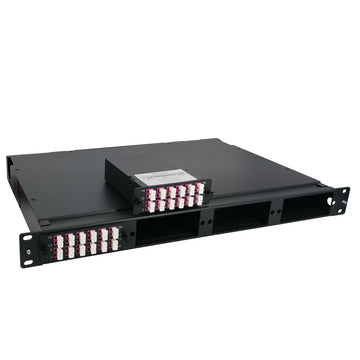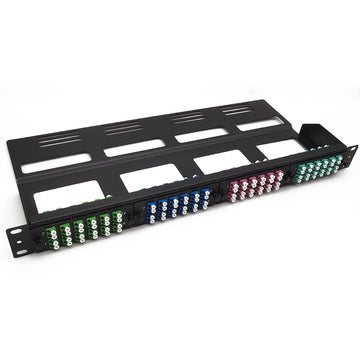What Is The Difference: SFP vs SFP+
Today there are different optical transceivers available on the market. They come in various form factors offering speeds from 100Mbps to 100Gbps and are fully compliant to the MSA and IEEE 802.3 standards. Some of the more popular form factors include SFP, SFP+, XFP, GBIC, XENPAK, QSFP and QSFP28. As we know, a SFP module just looks the same as the SFP+ module. And most switches can both support SFP module and SFP+ module. So, do these two modules really refer to the same one? What’s the difference between SFP vs SFP+?

SFP Definition
SFP can also called “Small Form-factor Pluggable”. It is a hot-pluggable transceiver that plugs into the SFP port of a network switch and supports SONET, Gigabit Ethernet, Fibre Channel, and other communications standards. SFP specifications are based on IEEE802.3 and SFF-8472. They are capable of supporting speeds up to 4.25 Gbps.
Due to its smaller size, SFP replaces the formerly common gigabit interface converter (GBIC). Unlike GBIC which has a SC fiber optic interface, SFP has a LC interface and the main body size of SFP is only about half of the GBIC. They offer a cost effective way to connect a single network device to a wide variety of fiber cable distances and types. Therefore SFP is also called Mini-GBIC.
By choosing different SFP module, the same electrical port on the switch can connect to different fiber types (multimode or single-mode) and different wavelengths.
SFP+ Definition
SFP+ stands for Small Form-factor Pluggable Plus. It is a hot-pluggable transceiver that plugs into the SFP port of a network switch and supports SONET, Gigabit Ethernet, Fibre Channel, and other communications standards. SFP+ transceivers are an enhanced version of the SFP that can support data rates of up to 16Gbps.
As one of the most popular industry standards it is supported by many network component vendors. SFP+ supports 8 Gbit/s Fibre Channel, 10 Gigabit Ethernet and the Optical Transport Network standard OTU2. SFP+ modules come in two types linear and limiting. Linear SFP+ modules are most appropriate for 10GBase-LRM, otherwise, limiting modules are preferred. These contain a signal amplifier to re-shape the degraded (received) signal whereas linear does not.
In today’s most applications, SFP+ module usually supports 8 Gbit/s Fibre Channel, 10 Gigabit Ethernet and Optical Transport Network standard OTU2. In comparison to earlier 10 Gigabit Ethernet XENPAK or XFP modules, SFP+ module is smaller and becomes the most popular 10 Gigabit Ethernet module in the market.

SFP vs SFP+
- Speed and compatibility. SFP+ ports can accept SFP optics but at a reduced speed of 1 Gbit/s. And an SFP+ transceiver can not be plugged into an SFP port, otherwise, the product or port may be damaged.
- Compatibility. SFP+ is used in 10-Gigabit Ethernet applications while SFP is for 100BASE or 1000BASE applications.SFP complies with standards of IEEE802.3 and SFF-8472 while SFP+ is based on SFF-8431.
- Different costs. SFP+ is more expensive than SFP.
- Data rates.Since SFP supports only up to 4.25 Gbps, SFP+ that supports data rates up to 16 Gbps was later introduced. In fact, SFP+ is an enhanced version of the SFP.
| Optics Type | Optics Type | Data Rate | Wavelength | Fiber Type | Max Distance | Typical Connector | DOM | Operating Temperature |
| SFP | SFP MSA | 155Mbps 622Mbps 1.25Gbps 2.125Gbps 2.5Gbps 3Gbps 4.25Gbps |
850nm 1310nm 1550nm CWDM DWDM BIDI |
OM1 OM2 OS1 OS2 |
160km | LC SC RJ-45 |
NO or YES | Commercial/Industrial |
| SFP+ | IEE802.3ae SFF-8431 SFF-8432 |
6Gbps 8.5Gbps 10Gbps |
850nm 1310nm 1550nm CWDM DWDM BIDI Tunable Copper |
OM3 OM4 OS1 OS2 |
120km | LC RJ-45 |
YES | Commercial/Industrial |
SFP vs SFP+ Applications
Ethernet Application
SFP (1Gbps)
- 1000BASE-SX SFP 850nm 550m
- 1000BASE-LX/LH SFP 1310nm 20km
- 1000BASE-EX SFP 1310nm 40km
- 1000BASE-ZX SFP 1550nm 80km
SFP+ (10Gbps)
- 10GBASE-SR SFP+ 850nm 300m
- 10GBASE-LRM SFP+ 1310nm 220m
- 10GBASE-LR SFP+ 1310nm 10km
- 10GBASE-ER SFP+ 1550nm 40km
- 10GBASE-ZR SFP+ 1550nm 100km
Fiber Channel Application
SFP (2G, 4G)
-
125Gbps:
- 2G Fibre Channel SFP 1310nm 2km/15km/20km/40km
- 2G Fibre Channel SFP 1510nm 80km
-
25Gbps:
- 4G Fibre Channel SFP 850nm 150m
- 4G Fibre Channel SFP 1310nm 5km/10km/15km/20km
SFP+ (8G)
-
5Gbps:
- 8G Fibre Channel SFP+ 850nm 150m
- 8G Fibre Channel SFP+ 1310mn 10km/20km/40km
- 8G Fibre Channel SFP+ 1510nm 80km
SONET/SDH Application
SFP (155Mbps, 622Mbps, 2.5Gbps)
-
155Mbps:
- OC-3/STM-1 1310nm 2km/15km/40km
- OC-3/STM-1 1510nm 80km
-
622Mbps:
- OC-12/STM-4 1310nm 500m/2km/15km/40km
- OC-12/STM-4 1510nm 80km
-
5Gbps:
- OC-48/STM-16 1310nm 2km/15km/40km
- OC-48/STM-16 1510nm 80km
SFP+ (10G)
- OC-192/STM-64 850nm 300m
- OC-192/STM-64 1310nm 2km/10km/20km/40km
- OC-192/STM-64 1510nm 80km
Conclusion
It's clear that the main driving force behind the evolution of optical transceiver is the need to achieve higher bandwidth rates with smaller form-factor. In modern, dense networks, small form factors are a constant necessity. After a clear understanding of them, you also have to consider your network traffic, transmission distance, and future-proof networking requirements for ensuring the right selection. Which SFP or SFP+ module should you choose all depends on your switch types. LightOptics is a reliable SFP transceiver module manufactures, all SFP module and SFP+ module types are available in www.lightoptics.co.uk. If you have any further questions about transceivers, you can always get in touch with LightOptics staff via sales@lightoptics.co.uk.












